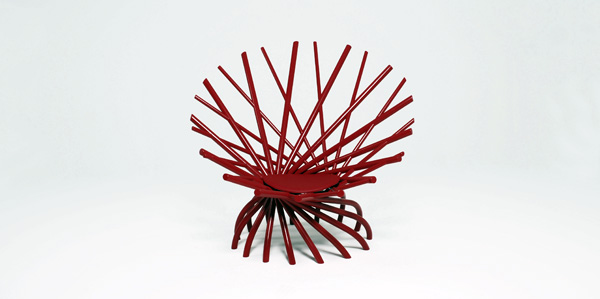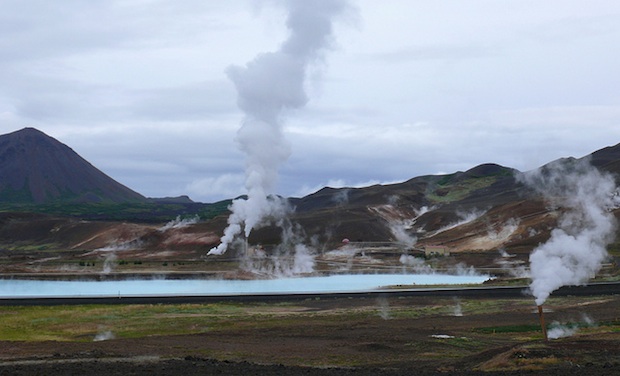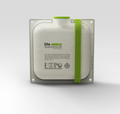 The percentage of Carbon Disclosure Project Supply Chain members who track and report supply chain emissions more than doubled to 45% in 2010, from 20% in 2009. The survey found that while 72% of members have at least some of their data verified externally, only 39% of suppliers do so, mainly due to high costs [...]
The percentage of Carbon Disclosure Project Supply Chain members who track and report supply chain emissions more than doubled to 45% in 2010, from 20% in 2009. The survey found that while 72% of members have at least some of their data verified externally, only 39% of suppliers do so, mainly due to high costs [...]This twist (literally) on the chair, the brainchild of designer Markus Johansson, challenges the straight, rigid, and traditional forms of the modernist aesthetic, presenting itself as a violent and chaotic swirl of solid wood frozen in time. Combining modern and age-old technique, NEST is constructed of a free form combination of round pegs that are bent and then drilled in a CNC milling machine for a precision fit. The pegs share an identical cut, making production easy and straightforward without sacrificing style.
Designer: Markus Johansson














----------
Yanko Design
Timeless Designs - Explore wonderful concepts from around the world!
Yanko Design Store - We are about more than just concepts. See what's hot at the YD Store!

Another addition has been made to the list of new inventions that promote green environment. This time it is a uniquely designed electric vehicle developed by a group of students from the University of Adelaide. EDWARD, as it is known, is the abbreviated form of “Electric Diwheel With Active Rotation Damping”. It is a distinctive vehicle whose main component is a set of two wheels fitted together through an axle and rest of the paraphernalia. The apparatus includes a seat for the driver and driving mechanism. The driver sits between the wheels and handles the controls to maneuver EDWARD.

Due to the orientation of the two-wheels, the problem of balancing does not exist; however, the amusing posture of the driver as seen from the lateral view suggests he is driving from inside the wheels.
The students have taken extra care to provide rock-free ride by equipping EDWARD with dynamic lateral stability and slosh control to minimize the gerbling effect, which is the biggest challenge posed by the vehicle. The above mentioned control can be activated or de-activated in case of forceful braking or sudden acceleration. EDWARD can be promoted in the category of light vehicles to cover short distances.
Via: Ubergizmo

Geothermal energy basically refers to energy drawn from the hot Earth’s crust and is definitely an important renewable energy source. Scientists are constantly engaged in contriving technological developments to facilitate proper and regular use of this energy source. Most of the geothermal power plants have setups that involve drilling geothermal wells deep into the Earth’s interior, into which cold water is poured. This water goes down to the hot porous rocks and is then flushed out as natural hot water that turns to steam when it reaches the Earth’s surface. This steam is tapped and utilized for turning turbines that in turn generate electric power.
Carbon sequestration on the other hand refers to tapping carbon dioxide and storing it in reservoirs. This is generally done to prevent atmospheric concentration of greenhouse gases or to store carbon dioxide emitted from flue gases in power plants. Now these sequestration schemes involve pumping carbon dioxide from the surface to the interiors of the Earth’s crust. Earth Science researchers at the University of Minnesota have proposed a new theory. According to them if compressed carbon dioxide replaces water in conventional geothermal rigs, the results could be interesting and favorable. Termed as CPG or CO2-plume geothermal, the method could prove to be a two-fold solution. Carbon dioxide has the ability to penetrate porous rocks better than water and most importantly unlike water CO2 does not readily dissolve minerals, which it comes in contact with. In fact CPG will be more effective in areas where the standard water based geothermal plants may not work. And of course the benefit of Carbon sequestration is there.
Researchers are just toying with the idea theoretically and have applied for DOE funding to begin practical experimentation. If successful the new technology will herald a new era in generating power from geothermal resources.
Via: Popsci

The iPad is the latest “techrage” these days. The new iPad was sold in millions within 2 days of its launch. Steve Jobs has again wowed the world with what has now become an undeniably must-have accessory. We have to, however, agree that technology and greenery are often not very compatible terms. However, since technology is an inseparable part of people’s lives today, why not try to make the existing technologies more energy efficient and eco friendly. This article discusses the various devices and accessories that can make the iPad an eco-friendly gadget.
1. iPad 2 case and a bamboo skin from Grove

The American company, Grove has created dual wonders with a bamboo-backed case and a smart leather cover for a greener iPad. The case is made of 100% bamboo and is rubbed with natural oils and waxes. The leather cover is actually vegetable tanned and has magnetic sensors that switch the pad on when it is lifted and shut it down automatically when not it is in use. For a more personalized look, one can even get one’s name engraved upon the case. Natural and ethnic, it serves its purpose to the hilt.
2. Marware Eco-Flip iPad Case

The Marware cover is a minimal toxin leather case, which is actually RoHS compliant and free from the usage of excessive hazardous materials. It is sleek and sturdy and the top flap can flip back to act as a stand; the iPad can thus stand in a vertical position. This feature aids convenient viewing and also keeps the precious technology safe.
3. VersShellcase

Solid hardwood and bamboo make this verscase a beauty. It encases your device in a natural body and keeps it safe and toasty from the perils of the world. It comes with a smart attachment - a metal foot, which can lift up the device both horizontally and vertically for easy viewing.
4. Voltaic Spark - Solar Tablet Case

Packing in 8 watts of power, the voltaic spark is a solar powered iPad case that gives the iPad an extra hours run-time, provided that it is kept under direct sunlight. No charging, no plugs and wires, and no drawing unnecessary electricity when you have one of these in your possession. Moreover, the inbuilt battery can be charged with sunlight and utilized later.
5. ColcaSac- Zagora iPad Sleeve

Make your iPad look like a baby covered in cute and warm fur in the midst of harsh winter blazes with the Zagora case. Made from heavy duty basketweave canvas harvested in China, it is a reliable protector and costs just $35. So, carry the spirit of Alaska in your bags with this eco-friendly iPad warmer.
6. Kork - Natural Protection for iPad

With a pocket pinch of $71, the Kork case is made of recycled cork and is a lovely, aesthetically pleasing design. Apart from the look, it also delivers functionality with its clever cuts and and enables audio output with better sound projection.
7. Proporta Leather Case for iPad

It may look like any other leather casing with a flap support and and standing provision, but it is a little more than that. It is made of 100% recycled leather with a natural hessian lining. One can call it the unsung hero as it hides its attributes in a facade of sheer style.
8. Solar Charger Case

Another solar powered casing that has a high convert efficiency of over 16% and has a full charge life of 8-12 hours. Furthermore, it lasts for 500 charges and has a shelf life of around ten years. It packs in killer looks and sleek lines that are so devilish that one cannot guess that it is in fact a casing made for a green cause!
9. JAVOedge’s Corky Back Cover

Another cork wonder, the JAVOedge cover actually showcases the texture of corks in a very stylish way. The back looks like it has been assembled by compressing round corks against each other, giving it a style statement that cries out loud for attention. Made from 100% recycled material, it is visually appealing and gives the iPad that extra punch.
10. Solio Solar Charger

The Solio solar charger looks like a pseudo metallic flower which has bloomed in the sunlight. It takes charge from the sun with its tri-battery mechanism and helps save a lot of energy. The petal like batteries can also hold a single charge for one year if not utilized. Although one has to fish out $99.95 for this solar wonder, it is worth every penny for it takes the green road and provides non-electric charging to the user.
Clean power from the Earth used to use a lot of water. But a new discovery means that water can be replaced with CO2, which gets left in the ground and doesn't alter the climate.

Work by scientists at the University of Minnesota could result in a new way to capture heat from underground geothermal sources, which lets us generate clean electrical energy for our own uses while simultaneously disposing of some of the CO2 that's responsible for global warming. Though it sounds implausibly positive, it actually all lines up in terms of science, and best of all, this piece of lateral thinking was achieved in a flash of inspiration during a road trip--the best type of idea.
The way geothermal energy is usually tapped for power generation is by drilling a couple of shafts deep into the earth, and pumping high-pressure water down one shaft. This makes its way through a hot rock layer (which gets its heat from the essentially inexhaustible energy of nearby plumes of hot lava) to the second shaft, picking up heat en route. The resulting steam is used to push a turbine, and generate power.
Except that two scientists pondered: What if the water in this equation was replaced with high-pressure carbon dioxide? Because it's a gas rather than a liquid, CO2 can ferret its way into more and tinier cracks in the sub-surface hot rocks than water--making the new system more feasible in areas water-based geothermal sources aren't deemed practical.
Water-based geothermal plants also suffer from blockages, where the water dissolves the rocks (or parts of them, like the mineral content) around it and prevents reliable flow of water through the loop. Water can also be hard to truck in to where the geothermal power plants are located. CO2 systems don't suffer the same issues. And if your geothermal system is also an oil well--as some of them are--the pumping in of CO2 can help push out the crude you're trying to extract.
The CO2 gas in question is sucked from the atmosphere, and is thus safely "trapped" in closed-loop systems in the geothermal plant, and partly dissolved into sub-surface materials. Exactly as proposed by some CO "burial" schemes.
Essentially, it's a win-win, and the team behind it has already received grants to develop the idea. They're planning a spin-off firm, so we may see the principle tested in real life sooner than you think.
[Image: Flickr user billward]
Chat about this news with Kit Eaton on Twitter and Fast Company too.
Read More: Volcanic Magma Could Provide Geothermal Energy
Peter Danko’s NoCo2 chair has astonishing ergonomic properties and makes use of old die cut automobile tires. The tires allow the seat and back to float with user movement. This design is obviously green in content and demonstrates that recycling can be elegant, fun, and more than just “social responsibility”.
Permalink |
Add to
del.icio.us |
digg
Post tags: "green furniture", eco chair, eco design, eco furniture, green chair, green design, green products, NO CO2 Chair, peter danko, sustainable design

A few months ago, I asked an executive from a Chinese manufacturer of LED streetlights what made his fast-growing company different from the thousands of lighting fixture makers popping up all over the country.
Simple, he said. He bought his LEDs—the chips inside the street lamps that actually produce light--from Cree, the North Carolina-based chip maker.
While China has colonized solar and pretty much every other heavy industry, the country still lags, according to many, when it comes to solid state lighting. Simply put, Chinese LEDs, and lights made with Chinese LEDs, don’t have a great reputation. Chinese LEDs and bulbs costs less, but anecdotes and word-of-mouth comments often tend to focus on inadequate light output, poor color rendering and other issues.
Part of the problem comes from the complexity of making solid state lights. The quality of an LED depends on the epitaxial, or crystal growing, processes employed to turn a lab-manufactured sapphire ingot into a wafer that can be chopped up into chips. The engineers who know how to do this are relatively small in number and most of them work in Germany, Japan and the U.S. (Yes, many of the complaints about Chinese LEDs come from western companies.)
Making light fixtures also requires know-how in optics and design. Lunera, a Silicon Valley startup, was co-founded by a guy that once worked as a lighting designer for Annie Liebovitz. You don’t meet a lot of people in solar whose work showed up regularly in Vogue.
Will it change? Sure, over time. And that’s why GSR Ventures, which specializes in Chinese investments, has plunked $10 million into SunSun Lighting, which makes LED bulbs. SunSun has a 9 watt bulb that puts out as much light as a 60 watt bulb. The company’s secret sauce revolves around its PowerXplore technology, electronics which help drive light and boost overall efficiency.
The big hurdle facing SunSun remain the intangibles. Will the light bulbs produce enough light? Will the light be a warm, white light or will it be a cool blue, sort of like the light that might emanate from the business end of an alien medical probe? Will they last? Will Home Depot sell them, or will they get scared away by fears about returns and people confusing them for solar panels?
And how will the compare against bulbs like the liquid-filled LED bulb coming from Switch that will cost $25 toward the end of the year?
And who is making the LEDs? Even Western companies advertise, Intel Inside-like, when they employ Osram or Cree LEDs.
Believe me. Light bulbs look simple, but in the past year I’ve tested one heck of a lot of bulbs. They all have different personalities. Many are great, even for the price, but some certainly suck.
Then again, the selling point here may be electronic engineering. SunSun could ultimately become a component supplier to bulb makers, i.e. it could sell PowerXplore technology to others who would have to worry about placating finicky American consumers. Switching business models, if possible, would help the company limbo under a lot of the issues above. Think of it. In a "horizontal" lighting market, you could have established companies make the LEDs and some phosphors, Chinese, Korean and/or Taiwanese companies produce the supporting electronics and phosphors, and someone from the west design bulbs and lamps with Chinese or Taiwanese contract manufacturing backing them up.
GSR is also an investor in ShineOn, which makes LED packaging, a crucial (yet faceless) component for LED bulbs. We profiled them a few months ago. ShineOn when it jraised $51.5 million from Accel, Mayfield, GSR and others.





Comments by our Users
Be the first to write a comment for this item.